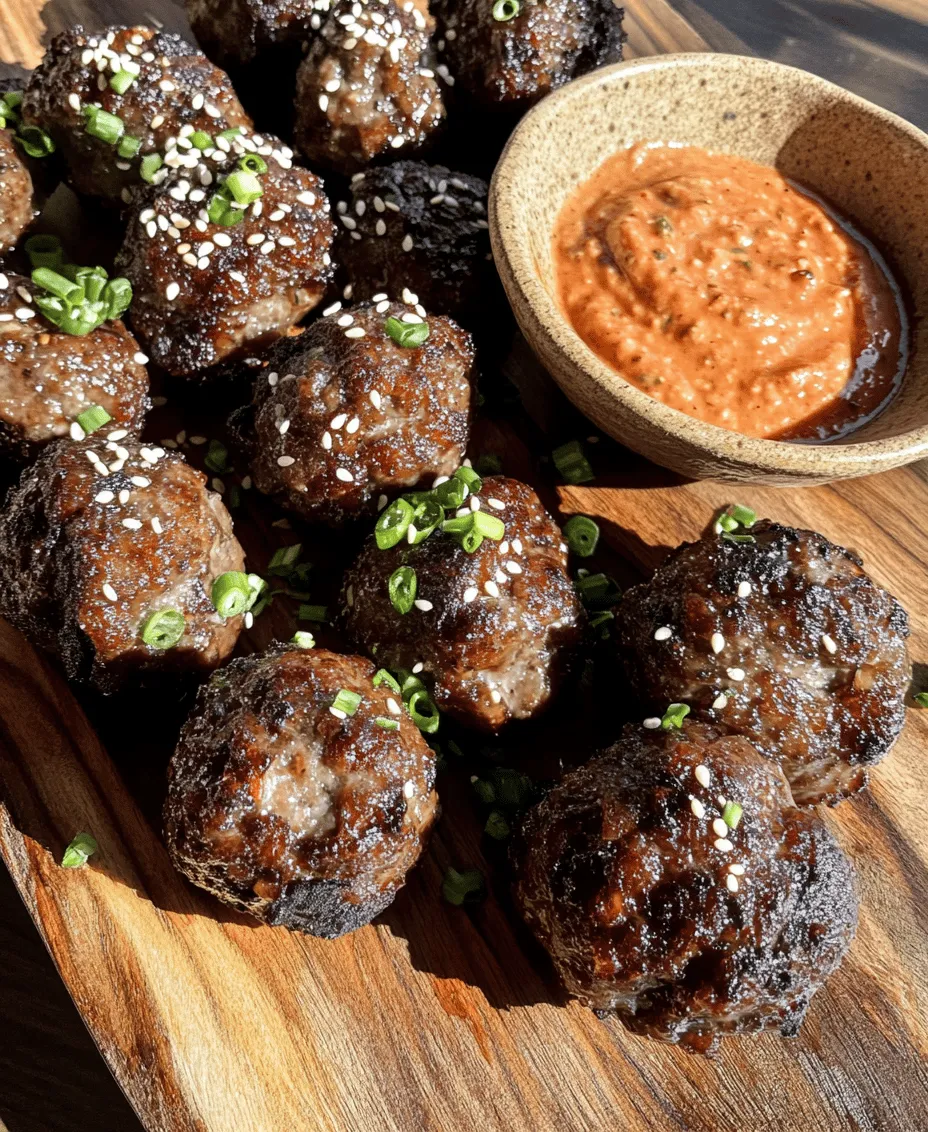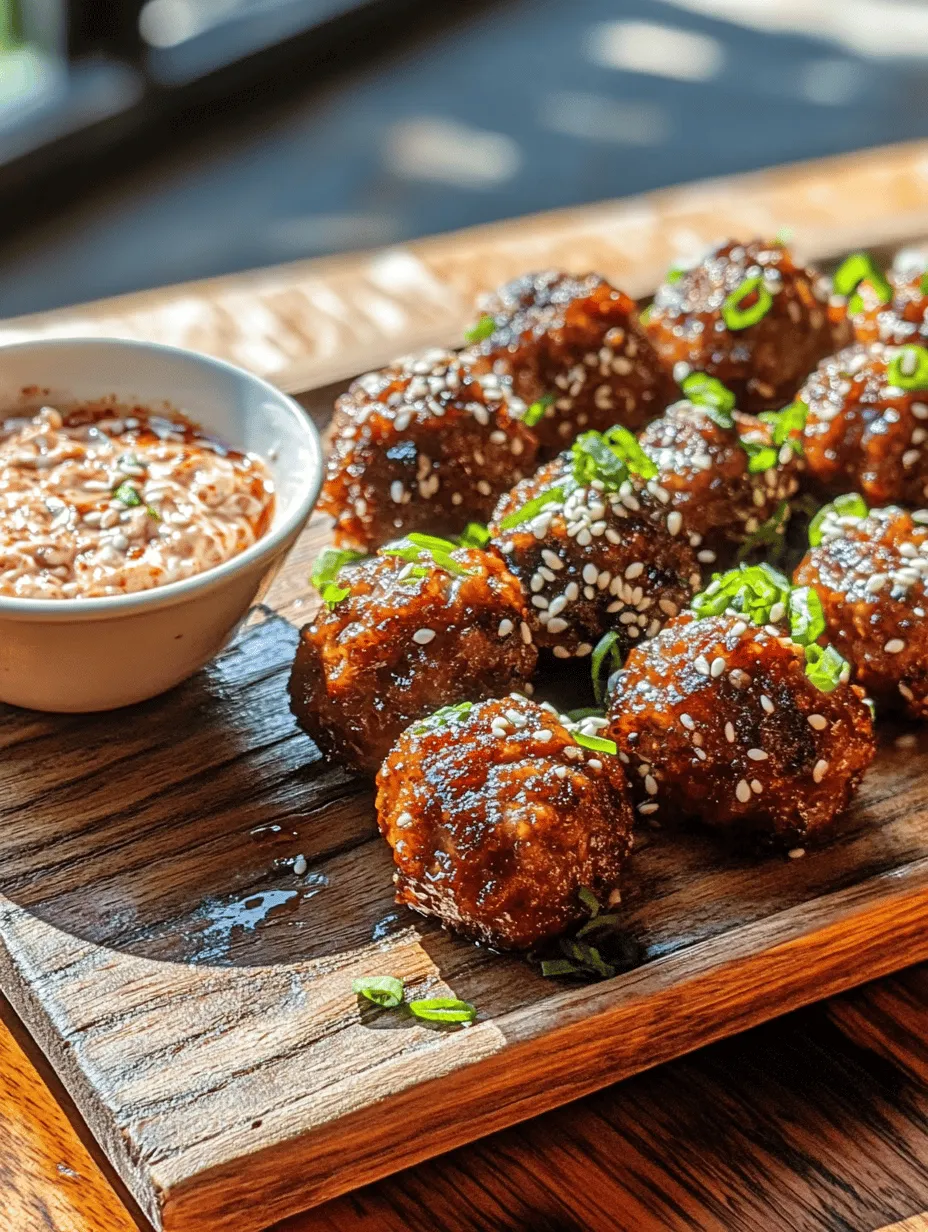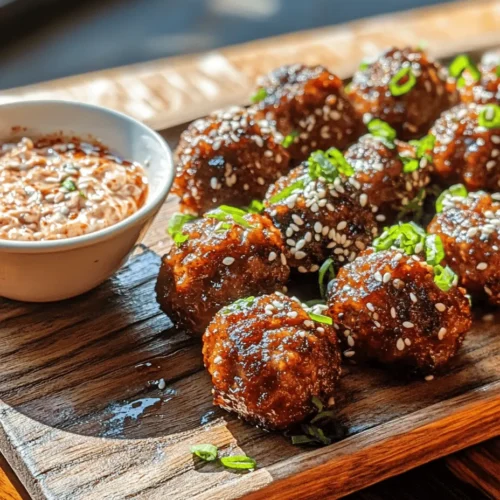Introduction
Korean cuisine has captured the hearts and palates of food enthusiasts around the globe. Known for its bold flavors, vibrant colors, and diverse textures, Korean food offers an exciting culinary experience that celebrates the art of balance between savory, sweet, spicy, and umami. Among its many delightful dishes, Korean BBQ stands out as a true representation of this culinary philosophy, where marinated meats are grilled to perfection and enjoyed with an array of dipping sauces. One such dish that embodies the essence of Korean BBQ while adding a unique twist is Korean BBQ Meatballs with Spicy Mayo Dip.
These meatballs are not only a delightful fusion of flavors but also a versatile dish that can be served as an appetizer, a main course, or even as a fun finger food at gatherings. Infused with the rich tastes of traditional Korean BBQ and paired with a creamy, spicy mayo dip, these meatballs are sure to impress your family and friends. In this article, we will explore the essence of Korean BBQ flavors, break down the star ingredients that make these meatballs shine, and guide you through the process of creating the perfect meatball mixture and baking them to golden perfection.
Understanding Korean BBQ Flavors
To truly appreciate Korean BBQ meatballs, it’s essential to understand the foundational flavors that characterize Korean cuisine. Traditional Korean BBQ revolves around high-quality meats marinated in a rich blend of ingredients that elevate their natural flavors. The marinade often includes elements such as soy sauce, sesame oil, garlic, ginger, and sugar, each contributing to the umami-rich profile of the dish.
The Role of Umami and Spice in Korean Cooking
Umami, often referred to as the fifth taste, plays a pivotal role in Korean cooking. This savory taste is derived from ingredients like fermented soy sauce and gochujang (Korean chili paste), which are frequently used in marinades and sauces. In addition to umami, spice is a defining characteristic of Korean cuisine, providing heat and depth to dishes. The balance of these flavors is what makes Korean BBQ so comforting and satisfying, inviting diners to savor each bite.
Connection Between Korean BBQ and Comfort Food
Korean BBQ is not just about the food; it’s about the experience. Dining on Korean BBQ often involves grilling meats at the table, allowing diners to engage with their food and each other. This communal aspect creates a warm, inviting atmosphere that is synonymous with comfort food. The Korean BBQ Meatballs with Spicy Mayo Dip capture this spirit, offering a fun, shareable dish that brings people together while showcasing the beloved flavors of Korea.
The Star Ingredients of Korean BBQ Meatballs
Creating the perfect Korean BBQ meatballs requires a harmonious blend of ingredients that not only enhance the flavor but also contribute to the texture and overall experience of the dish. Below, we delve into each of the primary ingredients that make these meatballs a standout.
Ground Beef and Pork: Benefits of Using a Meat Blend
A key component of these meatballs is the blend of ground beef and pork. This combination offers the best of both worlds: the robust flavor of beef and the juiciness of pork. Using a blend ensures that the meatballs retain moisture during cooking, resulting in a tender and flavorful bite. Additionally, the fat content from the pork helps to keep the meatballs succulent, while the beef adds depth and richness.
Jasmine Rice: Role as a Binder and Flavor Enhancer
Incorporating jasmine rice into the meatball mixture serves multiple purposes. Not only does it act as a binder, helping to hold the meat together, but it also adds a subtle sweetness and aromatic flavor that complements the savory elements of the dish. Jasmine rice is known for its delicate fragrance, which enhances the overall sensory experience of the meatballs.
Fresh Herbs and Spices: Importance of Green Onions, Garlic, and Ginger
Fresh herbs and spices are crucial for elevating the flavor profile of Korean BBQ meatballs. Green onions lend a mild onion flavor and a pop of color, while garlic and ginger provide warmth and aromatic qualities. These ingredients not only enhance the taste but also add freshness to the meatballs, balancing the richness of the meat.
Soy Sauce and Sesame Oil: Their Impact on Flavor and Authenticity
Soy sauce is a staple in Korean cooking, imparting a deep, savory flavor that is essential to the marinade. It adds saltiness and complexity, enhancing the overall taste of the meatballs. Sesame oil, on the other hand, adds a distinctive nutty aroma that is characteristic of Korean cuisine. Together, these ingredients create an authentic flavor profile that transports you to a bustling Korean BBQ restaurant.
Sugar and Black Pepper: Balancing Flavors and Enhancing Taste
To round out the flavor profile, a touch of sugar and black pepper is added to the meatball mixture. Sugar helps to balance the saltiness of the soy sauce and the heat from the spices, while black pepper provides a gentle kick. This combination of flavors ensures that each meatball is well-rounded and satisfying.
Creating the Perfect Meatball Mixture
Now that we’ve explored the essential ingredients, let’s dive into the process of creating the perfect meatball mixture. The key to achieving the ideal texture and flavor lies in the method of combining the ingredients.
Step-by-Step Guide on Mixing Ingredients for Optimal Texture
1. Gather Your Ingredients: Begin by measuring out all your ingredients. This includes the ground beef and pork, cooked jasmine rice, finely chopped green onions, minced garlic, grated ginger, soy sauce, sesame oil, sugar, black pepper, and any other seasonings you wish to include.
2. Combine the Meats: In a large mixing bowl, combine the ground beef and pork. Using your hands or a spatula, gently mix the meats together until they are just combined.
3. Add the Aromatics and Seasonings: Next, add the cooked jasmine rice, green onions, garlic, ginger, soy sauce, sesame oil, sugar, and black pepper to the meat mixture.
4. Mix Gently: With clean hands, mix the ingredients together until they are just combined. Take care not to overmix, as this can lead to tough meatballs. The goal is to incorporate all the ingredients without compressing the meat too much.
5. Let the Mixture Rest: After mixing, cover the bowl with plastic wrap and let the mixture rest in the refrigerator for at least 30 minutes. This resting period allows the flavors to meld and the mixture to firm up, making it easier to shape into meatballs.
Tips on Avoiding Overmixing to Ensure Tenderness
When it comes to meatballs, tenderness is key. Overmixing can cause the proteins in the meat to become too compact, resulting in a dense texture. Here are some tips to keep your meatballs light and fluffy:
– Use a Light Touch: When mixing, use your hands to gently fold the ingredients together instead of kneading them. This helps to keep the mixture airy.
– Do Not Overwork: Mix just until the ingredients are combined. A few visible streaks of meat are fine; they will blend together during cooking.
– Rest the Mixture: Allowing the mixture to rest not only enhances flavor but also helps the proteins relax, resulting in a more tender meatball.
Shaping and Baking the Meatballs
Once your meatball mixture is ready, it’s time to shape and bake them to perfection. The way you shape your meatballs can affect their cooking time and overall texture, so it’s essential to follow a few techniques for uniformity.
Techniques for Shaping Uniform Meatballs for Even Cooking
1. Preheat the Oven: Before you begin shaping your meatballs, preheat your oven to 400°F (200°C). A hot oven ensures that your meatballs will cook evenly and develop a nice, golden crust.
2. Use a Cookie Scoop: To create uniform meatballs, use a cookie scoop or ice cream scoop. This tool helps you measure out consistent portions, ensuring that all meatballs cook at the same rate.
3. Roll Gently: Once you have your portion, roll the mixture between your palms to form a ball. Aim for a size that is about 1 to 1.5 inches in diameter. Avoid compressing the meat too tightly; a light touch will help maintain fluffiness.
4. Place on a Baking Sheet: Line a baking sheet with parchment paper for easy cleanup. Arrange the meatballs on the sheet, leaving space between them for even cooking.
5. Bake to Perfection: Once shaped, place the baking sheet in the preheated oven and bake for 18-20 minutes, or until the meatballs are cooked through and reach an internal temperature of 160°F (71°C).
By following these steps, you’ll ensure that your Korean BBQ meatballs are not only delicious but also visually appealing, making them a perfect addition to your dining table or party spread. In the following sections, we will delve into the preparation of the spicy mayo dip that complements these flavorful meatballs, as well as tips for serving and enjoying this delightful dish. Stay tuned for the next part as we continue our culinary journey through the rich flavors of Korean BBQ!




